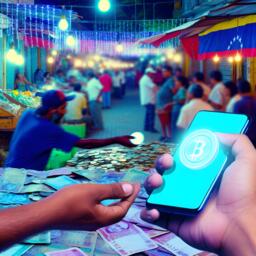Venezuela's Crypto Revolution: How USDT Became the "Binance Dollar" and Replaced the Collapsing Bolívar
With 229% inflation destroying the national currency, Venezuelans have turned to an unexpected savior: the USDT stablecoin. Discover how "Binance dollars" are bringing stability to a country in economic chaos.

The "Binance Dollar": USDT Becomes Venezuela's Unofficial National Currency
In Venezuela, skyrocketing inflation has pushed citizens to adopt an unexpected solution to protect their purchasing power: Tether's USDT stablecoin. With annual inflation reaching a staggering 229%, the Venezuelan bolívar has become practically unusable for everyday transactions. Merchants and consumers are now turning to what locals call the "Binance dollar" - a reference to USDT's P2P rate on Binance - to set prices and make payments.
How USDT Became Venezuela's De Facto Currency
Facing hyperinflation, Venezuela is experiencing a de facto dollarization, but not in its traditional form. Instead of physical greenbacks, the USDT stablecoin has emerged as the reference currency. Merchants now use the P2P rate of USDT on Binance to determine prices, avoiding the constant fluctuations of the bolívar. This practice, nicknamed "dólares Binance," has brought stability to transactions in an otherwise chaotic economic environment.
Transfers primarily occur on the Tron (TRC-20) network, preferred for its minimal fees and widespread local adoption. This infrastructure allows households and small businesses to manage their finances in digital dollars, which are more accessible than physical bills - a rarity due to international sanctions.
A Digital Solution to Hyperinflation
Several factors have accelerated this transition to stablecoins:
- Monthly inflation of 26% makes the bolívar virtually unusable for routine transactions
- The scarcity of physical dollars forces economic actors to seek digital alternatives
- Government policies, while repressive toward the parallel market, increasingly tolerate cryptocurrency use in private exchanges
According to data collected by specialists, on-chain activity in Venezuela has doubled between 2023 and 2024, with stablecoins representing 47% of transactions under $10,000. This massive adoption of cryptocurrencies places the country among global leaders in daily digital asset usage, according to blockchain analysis firm Chainalysis.
Redefining Economic Rules Through Blockchain
The case of Venezuela perfectly illustrates how stablecoins can serve as a lifeline in economies experiencing severe crisis. By offering a stable alternative to the bolívar, USDT allows Venezuelans to continue living - or rather surviving - and trading despite devastating inflation.
Transactions occur primarily through mobile applications, with many Venezuelans now more familiar with crypto wallets than traditional banking apps. This grassroots adoption has created an entire parallel economy operating on digital rails, where the government's monetary policy has minimal impact.
While Bitcoin initially received attention as Venezuela's potential crypto savior, the practical reality has shown that stablecoins offer what the population truly needs: stability and predictability in daily transactions. USDT provides a hedge against inflation without exposing users to Bitcoin's volatility.
A Model for Other Crisis Economies?
As the Venezuelan government struggles to control the economic situation, blockchain and cryptocurrencies are taking over, redefining economic rules in the country. This phenomenon raises important questions about monetary sovereignty and the future of central banking in the digital age.
Could other countries facing similar challenges follow Venezuela's path? The growing adoption of stablecoins in Argentina, Turkey, and Lebanon suggests a broader pattern emerging. As traditional monetary systems fail, citizens are increasingly turning to digital alternatives that offer protection against inflation and currency controls.
Venezuela's cryptocurrency experiment wasn't planned or officially sanctioned - it emerged organically as a survival mechanism. While the government focuses on promoting its own digital currency initiatives, the people have already made their choice clear by embracing USDT as their unofficial national currency.